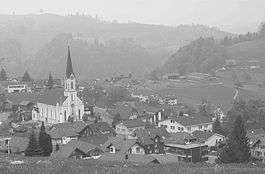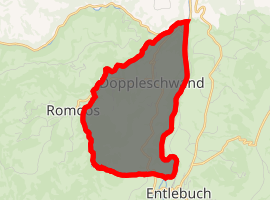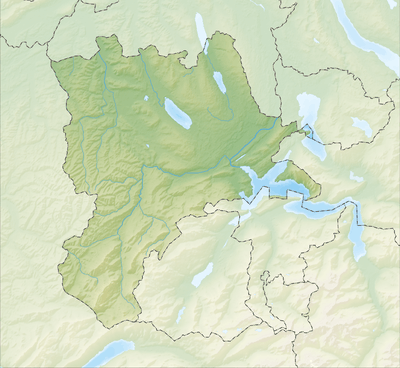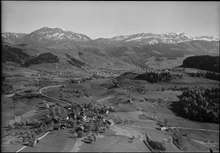Doppleschwand
Doppleschwand is a municipality in the district of Entlebuch in the canton of Lucerne in Switzerland.
Doppleschwand | |
|---|---|
 | |
 Coat of arms | |
Location of Doppleschwand 
| |
 Doppleschwand  Doppleschwand | |
| Coordinates: 47°1′N 8°3′E | |
| Country | Switzerland |
| Canton | Lucerne |
| District | Entlebuch |
| Area | |
| • Total | 6.95 km2 (2.68 sq mi) |
| Elevation | 751 m (2,464 ft) |
| Population (2018-12-31)[2] | |
| • Total | 782 |
| • Density | 110/km2 (290/sq mi) |
| Postal code | 6112 |
| SFOS number | 1001 |
| Surrounded by | Entlebuch, Hasle, Romoos, Wolhusen |
| Website | www Profile (in German), SFSO statistics |
History
Doppleschwand is first mentioned in 1275 as Togelswande or Towenswande.[3]
Geography

Doppleschwand has an area of 7 km2 (2.7 sq mi). Of this area, 55.5% is used for agricultural purposes, while 36.3% is forested. Of the rest of the land, 5.5% is settled (buildings or roads) and the remainder (2.7%) is non-productive (rivers, glaciers or mountains).[4] In the 1997 land survey, 36.55% of the total land area was forested. Of the agricultural land, 53.38% is used for farming or pastures, while 2.3% is used for orchards or vine crops. Of the settled areas, 2.59% is covered with buildings, 0.14% is industrial, 0.43% is classed as special developments, and 2.16% is transportation infrastructure. Of the unproductive areas, 2.3% is unproductive flowing water (rivers) and 0.14 is other unproductive land.[5]
The municipality is made up of the linear village of Doppleschwand which is located on the terrace between the Grosse Fontanne and the Kleine Emme rivers. It consists of the village of Doppleschwand and the hamlets of Gober, Holz and Oberhüseren.
Demographics
Doppleschwand has a population (as of 31 December 2018) of 782.[6] As of 2007, 2.4% of the population was made up of foreign nationals. Over the last 10 years the population has grown at a rate of 11.9%. Most of the population (as of 2000) speaks German (97.7%), with Albanian being second most common (1.7%) and Dutch being third (0.3%).
In the 2007 election the most popular party was the CVP which received 62% of the vote. The next three most popular parties were the SVP (23%), the FDP (10.8%) and the SPS (2.8%).
The age distribution in Doppleschwand is; 215 people or 30.1% of the population is 0–19 years old. 209 people or 29.3% are 20–39 years old, and 201 people or 28.2% are 40–64 years old. The senior population distribution is 72 people or 10.1% are 65–79 years old, 12 or 1.7% are 80–89 years old and 5 people or 0.7% of the population are 90+ years old.[5] The entire Swiss population is generally well educated. In Doppleschwand about 65.6% of the population (between age 25-64) have completed either non-mandatory upper secondary education or additional higher education (either university or a Fachhochschule).As of 2000 there are 217 households, of which 47 households (or about 21.7%) contain only a single individual. 38 or about 17.5% are large households, with at least five members.[5] As of 2000 there were 149 inhabited buildings in the municipality, of which 91 were built only as housing, and 58 were mixed use buildings. There were 59 single family homes, 23 two family homes, and 9 multi-family homes in the municipality. Most homes were either two (63) or three (23) story structures. There were only 2 single story buildings and 3 four or more story buildings.[5]
Doppleschwand has an unemployment rate of 0.48%. As of 2005, there were 111 people employed in the primary economic sector and about 34 businesses involved in this sector. 24 people are employed in the secondary sector and there are 7 businesses in this sector. 55 people are employed in the tertiary sector, with 17 businesses in this sector.[4] As of 2000 50.4% of the population of the municipality were employed in some capacity. At the same time, females made up 36.2% of the workforce.
In the 2000 census the religious membership of Doppleschwand was; 620 (94.9%) were Roman Catholic, and 14 (2.1%) were Protestant. There are 9 individuals (1.38% of the population) who are Muslim. Of the rest; there were 3 (0.46%) who do not belong to any organized religion, 7 (1.07%) who did not answer the question.[5]
The historical population is given in the following table:[3]
| year | population |
|---|---|
| 1745 | 390 |
| 1798 | 536 |
| 1837 | 681 |
| 1850 | 668 |
| 1900 | 523 |
| 1950 | 502 |
| 1970 | 470 |
| 2000 | 653 |
References
- "Arealstatistik Standard - Gemeinden nach 4 Hauptbereichen". Federal Statistical Office. Retrieved 13 January 2019.
- "Ständige Wohnbevölkerung nach Staatsangehörigkeitskategorie Geschlecht und Gemeinde; Provisorische Jahresergebnisse; 2018". Federal Statistical Office. 9 April 2019. Retrieved 11 April 2019.
- Doppleschwand in German, French and Italian in the online Historical Dictionary of Switzerland.
- Swiss Federal Statistical Office Archived January 5, 2016, at the Wayback Machine accessed 17-Aug-2009
- LUSTAT Lucerne Cantonal Statistics Archived November 27, 2011, at the Wayback Machine (in German) accessed 12 August 2009
- Swiss Federal Statistical Office - STAT-TAB, online database – Ständige und nichtständige Wohnbevölkerung nach institutionellen Gliederungen, Geburtsort und Staatsangehörigkeit (in German) accessed 23 September 2019
External links
| Wikimedia Commons has media related to Doppleschwand. |
- Doppleschwand in German, French and Italian in the online Historical Dictionary of Switzerland.